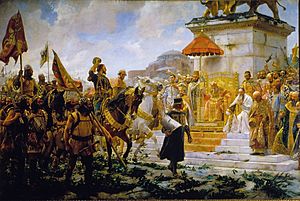Catalan Company facts for kids
The Grand Catalan Company (Catalan: Companyia Catalana d'Orient), also known as the Catalan Company, was a group of mercenaries. These were soldiers who fought for money, not for their home country. The Company was started by Roger de Flor in the early 1300s.
Contents
How the Company Started
Roger de Flor gathered soldiers who had lost their jobs after a peace treaty in 1302. This treaty, called the Peace of Caltabellotta, ended a war between the Crown of Aragon and the French rulers of Anjou.
In 1303, Roger de Flor offered his Company's help to the Byzantine emperor Andronicus II Palaeologus and his son, Michael IX Palaeologus. The Byzantine Empire was a Christian empire in the east. It was being attacked by the Turks, who were taking over land in Anatolia. The Turks had even created a powerful state called the Sultanate of Rum.
Both the Byzantine Empire and the Crown of Aragon accepted Roger de Flor's offer. The Crown of Aragon ruled Sicily and southern Italy. They were happy to get rid of these unemployed soldiers, who could sometimes cause trouble.
Roger de Flor set off with 39 galleys (large ships) and other transport ships. He brought about 1,500 knights (soldiers on horseback) and 4,000 Almogavars. Almogavars were special foot soldiers, mostly from Catalonia, Valencia, and Aragon. They were known for their tough fighting style.
The Company in the Byzantine Empire
In 1303, Roger de Flor arrived in Constantinople, the capital of the Byzantine Empire. King Frederick III of Sicily helped him get there. Roger de Flor married the niece of Emperor Andronicus, who was the daughter of the Tsar of Bulgaria. He was also given the important title of Megas Doux, which meant he was the head of the Byzantine fleet.
Roger de Flor and his Company fought in Anatolia. They won battles against the Turks. However, they also caused a lot of trouble for the local Byzantine people. They engaged in widespread violence and looting. Because of this, the Byzantines started to see the Catalans as little more than bandits.
The End of Roger de Flor
Roger de Flor's actions and the bad behavior of the Almogavars created problems with the Byzantine Emperor. On April 30, 1305, Roger de Flor was killed. About 300 of his cavalry and 1,000 of his infantry were also killed. They were attacked by the Alans, another group of foreign mercenaries working for the Emperor.
After Roger de Flor's death, the Company continued to cause destruction. For the next two years, they devastated the regions of Thrace and Macedonia in the Balkans. They even attacked Thessalonica by land and sea. They also raided the monasteries on Mount Athos. For a long time after this, Catalans were not allowed on the Athos peninsula by the monks.
Eventually, Bernat de Rocafort became the leader of the Company. He offered their services to Charles of Valois. Charles wanted to claim the Byzantine Empire for himself. In 1309, Charles of Valois's representative, Thibault de Chepoy, ended Rocafort's leadership. Rocafort was arrested and sent to Naples, where he died of hunger that same year.
In 1318, the Company expanded its power into Thessaly, taking control of the Duchy of Neopatria.
The Company's Final Years
The Catalan Company ruled parts of Greece until around 1388–1390. They were eventually defeated by the Navarrese Company, led by Pedro de San Superano and Juan de Urtubia. The Navarrese Company was allied with the Florentines, led by Nerio I Acciaioli of Corinth.
Nerio I Acciaioli's family controlled these lands until 1456. At that time, the Ottoman Empire conquered them. By then, the Grand Catalan Company, like many military groups, had faded from history.
About the Company's Story
The early history of the Catalan Company was written down by Ramon Muntaner. He was a former member of the Company. His book is called Crònica.
Images for kids
-
Peter the Great with his almogavars in the Battle of the Col de Panissars. Bartomeu Ribó Térriz (1866)
See also
 In Spanish: Gran Compañía catalana para niños
In Spanish: Gran Compañía catalana para niños






